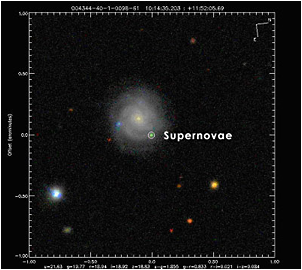 |
 |
 |
 |
 |
 |
 |
 |
 |
 |
|
Research @ KICP
|
Projects Archive: Nearby Supernova Factory, SNfactory Overview  Structures in the Universe The Nearby Supernova Factory is a dedicated program to analyze in detail a few hundred SNe Ia. The goal is to collect accurate spectra for each SN, starting 1-2 weeks before peak brightness, and continuing several weeks after peak brightness. Nearby SNe at low redshift (0.03 < z < 0.08) are selected. There are two main goals of the SNfactory: 1. Provide a larger, more accurately measured low-redshift SNe sample to compare with more distant SNe surveys. For measurements of dark energy density, the addition of the SNfactory sample will reduce the statistical uncertainty by about a factor of two. 2. SNe Ia are standard candles only after making a peak-brightness correction that depends on the measured decline rate of the luminosity. The SNfactory will look for additional peak brightness corrections, and investigate systematic issues such as evolution, progenitor star metallicity, and Type Ia purity vs. measurement quality. In the observable universe, there is about one SN Ia per second; however, less than 0.01% of these are within the desired redshift range of 0.03 < z < 0.08. To find enough of these low-redshift SNe Ia (100/year), about 1000 square degrees per night (few percent of the entire sky) must be searched. This large search is performed in collaboration with the Near-Earth Asteroid Team (NEAT), whose objective is to find and catalog all large objects near earth. Since the NEAT survey repeatedly scans the sky, a search pipeline is used to find supernovae by looking for objects that have brightened between two scans. Once a candidate SN Ia is found in the NEAT data, a spectrograph will record a detailed spectrum of the SN every few days. A specialized high-precision spectrograph, known as SNIFS, is under construction in Lyon, France. In 2004, SNIFS will be permanently mounted at the University of Hawaii 2.2-meter Telescope at the summit of Mauna Kea. SNfactory will have two half-nights per week to follow up SNe Ia that are found in the NEAT data. |





 Overview
Overview